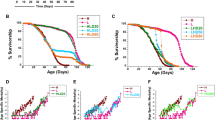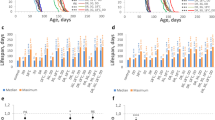Abstract
Superoxide dismutase (SOD) activities were determined for dietary dilution conditions that extend the life span of Drosophila melanogaster. The hypothesis motivating this research was that elevated SOD activity is associated with increased life span resulting from flies being held on a restricted diet. SOD activities were also measured for chico 1 which is a mutation in the insulin receptor substrate protein gene associated with life span extension. This allowed us to confirm the results of (Clancy et al. 2001) and extend the results by measuring CuZn SOD and Mn SOD activities in addition to the previously determined overall SOD activity. If the same form of SOD activity (CuZn SOD or Mn SOD) was elevated on the dilute diet that extends life span and in the long lived chico 1 homozygotes, then it would suggest that life span extension by dietary restriction and by insulin signaling mutations has a similar underlying mechanism. However, overall SOD activity, and CuZn SOD or Mn SOD activities did not differ among the diets tested. As observed previously (Clancy et al. 2001), overall SOD activity was elevated in chico 1 homozygotes compared to the heterozygote or wild type. Results from the present study indicate that elevated CuZn SOD activity, not Mn SOD, is the basis for the relatively high level of SOD activity in the chico 1 homozygotes.





Similar content being viewed by others
Abbreviations
- BCA:
-
Bicinchoninic acid
- DTPA:
-
Di-ethylenetriaminepentaacetic acid
- NaCN:
-
Sodium cyanide
- NBT:
-
Nitroblue tetrazolium
- ROS:
-
Reactive oxygen species
- SOD:
-
Superoxide dismutase
- TDB:
-
Triethanolamine, diethanolamine–HCl
References
Carlson KA, Nusbaum TM, Rose MR, Harshman LG (1998) Oocyte maturation and ovariole number in lines of Drosophila melanogaster selected for postponed senescence. Funct Ecol 12:514–520
Chapman T, Partridge L (1996) Female fitness in Drosophila melanogaster: an interaction between the effect of nutrition and of encounter rate with males. Proc Biol Sci 263:755–759
Clancy DJ, Gems D, Harshman LG, Oldham S, Stocker H et al (2001) Extension of life-span by loss of CHICO, a Drosophila insulin receptor substrate protein. Science 292:104–106
Fabrizio P, Pozza F, Pletcher SD, Gendron CM, Longo VD (2001) Regulation of longevity and stress resistance by Sch9 in yeast. Science 292:288–290
Fabrizio P, Liou LL, Moy VN, Diaspro A, Selverstone Valentine J et al (2003) SOD2 functions downstream of Sch9 to extend longevity in yeast. Genetics 163:35–46
Feuers RJ, Weindruch R, Hart RW (1993) Caloric restriction, aging, and antioxidant enzymes. Mutat Res 295:191–200
Friedman DB, Johnson TE (1988) A mutation in the age-1 gene in Caenorhabditis elegans lengthens life and reduces hermafrodite fertility. Genetics 118:75–86
Gems D, Partridge L (2001) Insulin/IGF signalling and ageing: seeing the bigger picture. Curr Opin Genet Dev 11:287–292
Harman D (1956) Aging: a theory based on free radical and radiation chemistry. J Gerontol 11:298–300
Hekimi S, Burgess J, Bussiere F, Meng Y, Benard C (2001) Genetics of lifespan in C. elegans: molecular diversity, physiological complexity, mechanistic simplicity. Trends Genet 17:712–718
Holzenberger M, Dupont J, Ducos B, Leneuve P, Geloen A et al (2003) IGF-1 receptor regulates lifespan and resistance to oxidative stress in mice. Nature 421:182–187
Honda Y, Honda S (1999) The daf-2 gene network for longevity regulates oxidative stress resistance and Mn-superoxide dismutase gene expression in Caenorhabditis elegans. Faseb J 13:1385–1393
Kenyon C, Chang J, Gensch E, Rudner A, Tabtiang R (1993) A C. elegans mutant that lives twice as long as wild type. Nature 366:461–464
Kim JD, McCarter RJ, Yu BP (1996) Influence of age, exercise, and dietary restriction on oxidative stress in rats. Aging (Milano) 8:123–129
Koizumi A, Weindruch R, Walford RL (1987) Influences of dietary restriction and age on liver enzyme activities and lipid peroxidation in mice. J Nutr 117:361–367
Kops GJ, Dansen TB, Polderman PE, Saarloos I, Wirtz KW et al (2002) Forkhead transcription factor FOXO3a protects quiescent cells from oxidative stress. Nature 419:316–321
Laganiere S, Yu BP (1989) Effect of chronic food restriction in aging rats. II. Liver cytosolic antioxidants and related enzymes. Mech Ageing Dev 48:221–230
Larsen PL (1993) Aging and resistance to oxidative damage in Caenorhabditis elegans. Proc Natl Acad Sci USA 90:8905–8909
Lee SS, Kennedy S, Tolonen AC, Ruvkun G (2003) DAF-16 target genes that control C. elegans lifespan and metabolism. Science 300:644–647
Luhtala TA, Roecker EB, Pugh T, Feuers RJ, Weindruch R (1994) Dietary restriction attenuates age-related increases in rat skeletal muscle antioxidant enzyme activities. J Gerontol 49:B231–B238
Martin GM., Austad SN, Johnson TE (1996) Genetic analysis of ageing: role of oxidative damage and environmental stresses. Nat Genet 13:25–34
Mockett RJ, Bayne AC, Sohal BH, Sohal RS (2002) Biochemical assay of superoxide dismutase activity in Drosophila. Methods Enzymol 349:287–292
Ogg S, Paradis S, Gottleiebe S, Patterson GI, Lee L et al (1997) The forkhead transcription factor DAF-16 transduces insulin-like metabolic and longevity signals in C. elegans. Nature 389:994–999
Paoletti F, Mocali A (1990) Determination of superoxide dismutase activity by purely chemical system based on NAD(P)H oxidation. Methods Enzymol 186:209–220
Parkes TL, Elia AJ, Dickinson D, Hilliker AJ, Phillips JP et al. (1998) Extension of Drosophila lifespan by overexpression of human SOD1 in motorneurons. Nat Genet 19:171–174
Partridge L, Gems D (2002) Mechanisms of ageing: public or private? Nat Rev Genet 3:165–175
Rao G, Xia E, Nadakavukaren MJ, Richardson A (1990) Effect of dietary restriction on the age-dependent changes in the expression of antioxidant enzymes in rat liver. J Nutr 120:602–609
Sun J, Tower J (1999) FLP recombinase-mediated induction of Cu/Zn-superoxide dismutase transgene expression can extend the life span of adult Drosophila melanogaster flies. Mol Cell Biol 19:216–228
Sun J, Folk D, Bradley TJ, Tower J (2002) Induced overexpression of mitochondrial Mn-superoxide dismutase extends the life span of adult Drosophila melanogaster. Genetics 161:661–672
Tatar M, Kopelman A, Epstein D, Tu MP, Yin CM et al. (2001) A mutant Drosophila insulin receptor homolog that extends lifespan and impairs neuroendocrine function. Science 292:107–110
Vanfleteren JR (1993) Oxidative stress and ageing in Caenorhabditis elegans. Biochem J 292 (Pt 2):605–608
Vanfleteren JR, De Vreese A (1995) The gerontogenes age-1 and daf-2 determine metabolic rate potential in aging Caenorhabditis elegans. Faseb J 9:1355–1361
Vanfleteren JR, De Vreese A (1996) Rate of aerobic metabolism and superoxide production rate potential in the nematode Caenorhabditis elegans. J Exp Zool 274:93–100
Wolkow CA, Kimura KD, Lee MS, Ruvkun G (2000) Regulation of C. elegans life-span by insulinlike signaling in the nervous system. Science 290:147–150
Acknowledgements
Raj and Barbara Sohal (University of Southern California) provided access to their method for measuring SOD activity that was unpublished at the time we conducted assays for this study and for insight into how to use this procedure. Irwin Segel (University of California at Davis) provided insight into the enzyme kinetics of the SOD assays employed in this study. Carmen Pauls maintained the cages that provided flies for enzyme assays and that were used for life span data. The research reported here was supported by a NSF Metabolite Signaling Center grant at the University of Nebraska—Lincoln (EPS-0346476) and by United States Army Grant DAAD19-03-1-0152.
Author information
Authors and Affiliations
Corresponding author
Rights and permissions
About this article
Cite this article
Kabil, H., Partridge, L. & Harshman, L.G. Superoxide dismutase activities in long-lived Drosophila melanogaster females: chico 1 genotypes and dietary dilution. Biogerontology 8, 201–208 (2007). https://doi.org/10.1007/s10522-006-9065-3
Received:
Accepted:
Published:
Issue Date:
DOI: https://doi.org/10.1007/s10522-006-9065-3




